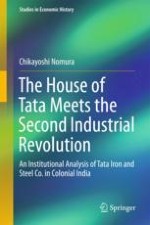2018 | OriginalPaper | Buchkapitel
6. The Financial Crisis of the 1920s, the Introduction of Tariff Protection and “Imperial Commitment”
verfasst von : Chikayoshi Nomura
Erschienen in: The House of Tata Meets the Second Industrial Revolution
Verlag: Springer Singapore
Aktivieren Sie unsere intelligente Suche, um passende Fachinhalte oder Patente zu finden.
Wählen Sie Textabschnitte aus um mit Künstlicher Intelligenz passenden Patente zu finden. powered by
Markieren Sie Textabschnitte, um KI-gestützt weitere passende Inhalte zu finden. powered by
